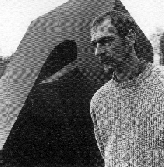Section Liège-Belgique

Section Liège-Belgique |  |
IDENTIFICATION SHEET. THE ARTIST :
Serge GANGOLF

NAME : GANGOLF
FIRST NAME : Serge
CITY : Verviers
BORN ON : 3 December 1943
EDUCATION : Institut Saint-Luc
EXHIBITIONS
1965/67 : Société des Beaux-Arts, Verviers
1968 : Galerie Baudoux, Liège
1971 : Kulturzentrum, Düren (D°
1972 : Galerie Primaver, Verviers
1974 : Société des Beaux-Arts, Liège
Galerie du Crédit Communal, Namur
1977/79 : Galerie Mathys, Herstal
1978 : Banque de Bruxelles, Verviers
1983 : Galerie Armorial, Bruxelles
1985 : Banque Bruxelles Lambert, Namur
1986 : Galerie Tendances Contemporaines, La Louvière
1987 : Skironio Museum, Skironio (GR)
1988 : Hôtel Saint-Loup, Namur
1989 : Musée de Louvain-La-Neuve (+Jo Delahaut)
: Galerie Le Triangle Bleu, Stavelot
1993/95 : Galerie Amaryllis, Brussel (+B. Mandeville, +Seuphor)
1994 : Galerie Le Triangel Bleu, Stavelot
1996 : Musée de la Pierre, Maffle
RIZES AND AWARDS
1974 Rome Prize
1985 Prix Egide Rombaux (Académie Royale de Belgique)
1995 Ville de QUEBEC
1997 Gran Premio de Honor (Resistencia - Chaco -
Argentina)
HIS WORK
1. In general
Relief "CITE "
aluminium
150/100 " ANCHE TU "
acier Cor-Ten
150/75/75
" SIGNAL "
Petit granit belge marbre blanc de Carrare aluminium coulé
10m/10m/5,3m
1994His sculpures are not representational. There is a balance between reflexions, pulsions, tensions, which is conveyed through the materials used with a lot of nuances and subtlety.
He uses Carrare marble, aluminium, stainless steel, stone. Each of Gangolf's sculptures reveals to us the hidden meaning of his mind and his concerns. His starts working on an essential volume (sphere, cylinder, cube...) in which he makes cuts or in which he integrates geometrical forms. The daring marriage of curbs and angles is a success. Progressively the integrated but still distinct forms celebrate the union of lyrism and geometrical rigor; the material becomes human. Gangolf puts a premium on closed form. The hollows he marks in the form, the cuts are like openings on the inner life of the work. The closed form hesitates between stability and dynamism. Gangolf'style is " classical "; we can say he's a creator of forms, he brings life to space, he's in love with his material.2. Description of one chosen work
NAME: " Sculpture-fontaine pour la Grand-Place de la ville de ATH "
DATE OF THE WORK: 1996
SIZE: 3m/5,7m/3m
MATERIAL: " Little Belgian Granite " - Stone from Vinalmont - White marble from CarrareA tall and narrow cylinder in the style of a " totem " is erected in the center of a large checked surface. Geometrical volumes of different forms and heights make the link between the cylinder and the base. The " totem " is carved with grooves made of soft lines and vertical orientations. The cylinder is surrounded by water which flows between the geometrical volumes situated at the base of the main element.
REFERENCE
The artist follows the trend called " Abstract Geometrical "
THE ARTIST SPEAKS
Serge Gangolf is a sculptor and a teacher at the Academy of Namur.
He says: " Being a teacher means being an experimented sculptor and having the ability to convey this experience to the students through exchanges.
He explains to his students: " You have to cut a way in the material you sculpt, to lead the spectator to it, so that he can penetrate into it. The art of sculpting is similar to that of writing. You have to be able to write to express yourself. You can also compare it to typography, where the punctuations, capital letters and especially the breathing spaces are essential. It's by working that you manage to give a balance and rhythm to a work. To master the technique, you first have to be aware of material, structure and space.
PERSONAL CONCLUSION
Serge Gangolf gave us a very warm welcome, which allowed me to meet the man and the artist, to approach his works on the premises of their creation. Serge Gangolf was quite happy to give us all kinds of explanations concerning his career, difficulties and enthusiasm.
His works, which are extremely simple in their synthesis and geometry show a real mastery in the play with forms, lines, hollows and projections and also in their creation. Each work is created in harmony with the pedestal.
The emotion felt when looking at the work probably comes from the modelling achievement associated with the humanism of an artist in his never-ending quest for perfection, in spite of a continuity in the style. Which incites me to say that Serge Gangolf has his own style...Bibiography
J. ParisseWork of Virginie Wayaffe 7 Prof. Arts
(Retour ARTE HomePage)